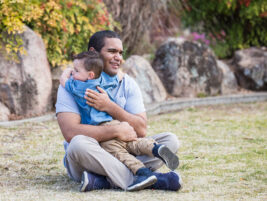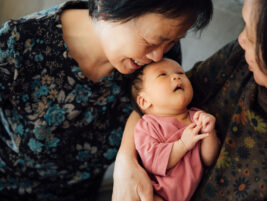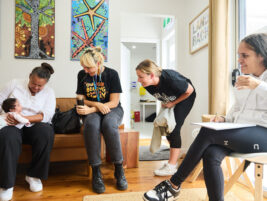DISCLAIMER: Dr. Alderman authored this article in her personal capacity. The views expressed in this article are solely those of the author and do not necessarily represent the views of any agency.
Introduction
As a developmental behavioral pediatrician, I straddle the two professional worlds of mental and physical health made artificially different not by the reality of my clients or the nature of my work but rather by decades of diverse history, education, training, research and funding streams. As a pediatrician I learned about child development. While in pursuit of my masters of public health, I learned about population health. But it was not until I studied infant mental health (IMH) and earned IMH endorsement that I began to see the infant mental health field as complementary to the pediatric profession yet far more inclusive of infant and toddler health and well-being. It was at that juncture that I began in my clinical approach to consider the capacity of the infant and young child as a full participant in the family (McHale, 2007).
IMH Principles Changed my Clinical Approach as a Developmental Pediatrician
There are many key principles and research-based theories within IMH that have changed my clinical approach as a developmental behavioral pediatrician. Perhaps the most fundamental change of all for me was the shift in my view of the child from that of a patient-clinician perspective to seeing the child within the relationships of the family and my role within relationships with the child and, perhaps even more importantly, the parents. Pediatricians are trained out of necessity to rely on the parents and partner with them for follow through on medical recommendations. For me, however, infant mental health took it beyond pragmatic considerations and made it the essence of the work and key to optimizing the child’s healthy social emotional development. Infant mental health also opened my eyes, to the importance of the child-caregiver relationship as the venue for promoting the child’s development. Focusing on that relationship identifies opportunities for promoting healthy social emotional development and prevention, early intervention and repair when the child’s social emotional development is moving off the healthy trajectory.
Introducing the Family
To illustrate, I would like to share a story about Judy, a three year old little girl, and her parents, Tom and Michelle. (Names have been changes to protect confidentiality.) Tom and Michelle came to my clinic for help to address Judy’s difficulty with sleep. Judy and her twin sister were Tom and Michelle’s second and third child. Their first child was a nine year old daughter who was developing typically and performing well in school. Judy’s twin sister was developing typically and doing well at home and in preschool. Tom and Michelle were experienced parents and recognized that the challenges they had managing Judy’s sleep problems were not typical.
Judy would take many hours every night to go to sleep. Her parents had tried many things but nothing seemed to work. They dutifully abided by Judy’s seemingly endless demands for her ever increasingly complicated bedtime routine. They had not yet transitioned Judy out of her crib for fear that without it she would not stay in bed after lights were turned out.
Judy’s crib was filled with toys that she needed each night. Tom followed Judy’s commands to carry her around her bedroom to touch each piece of furniture before being placed amongst the toys in her crib. Michelle always had Judy’s fuzzy piece of cloth ready for her as Tom placed her in the crib. Michelle read 10-15 books every night before the routine kisses and hugs and night-night farewell. Still, Judy protested and cried for an hour or so before she could go to sleep. Tom and Michelle were exhausted. Their confidence as parents had dwindled. They were open to any suggestions that might bring happiness into their evening time together.
Through the interview process, they also revealed that throughout the day there were other routines that Judy insisted on and things in her life that she needed or avoided in order to get through her day. Judy was slow to wake up in the morning, often arising cranky and unable to be persuaded to dress for the day until she had ample time on the living room sofa wrapped in her favorite blanket. She was sensitive to warm food and bath water. She was intolerant of tags on her clothes. In contrast, the tags on her stuffed animals were a pleasure for her to rub on her nose. Judy did not like the sun shining on her in the car. Unfortunately, she also could not tolerate wearing sun glasses. She gagged on soft foods but enjoyed crunchy snacks. Her parents were well aware of Judy’s preferences, tried their best to accommodate Judy’s needs and anxiously held their breath when others unknowingly did not respect the necessities of Judy’s controlled world. Judy was not adjusting well to preschool. She found the morning routine too rushed for her natural rhythm. She was unable to adapt to the school environment including being with the other children. Her resistance to getting ready for school was growing. She protested her mother’s departure from the classroom and cried each morning even though she had been attending her preschool class for several months. She tended to engage in solitary activities in school, mostly doing art work. Her parents had grown accustomed to the challenges present throughout the day and did not see them as problematic as the bedtime routine.
The first time I met Judy I saw a little girl carried into the room in her daddy’s arms. She was peeking out from behind her fuzzy cloth delicately held over her nose and thumb, which was hooked behind her upper front teeth. Her eyes were reddened and weepy. She was curious about me but reluctant to leave her daddy’s arms . She did eventually warm up, responded to her mother’s gentle encouragement and gradually moved from the sofa to the floor amongst an assortment of toys. She gravitated to the art supplies and briefly scribbled mono-colored designs with hard pressure on several sheets of paper. She collected all the blocks, stacked them next to her and forbade anyone from disrupting her arrangement. She had an ageappropriate sense of humor and would giggle with a glance toward her mother when I made silly faces.
Using an IMH Lens within my Practice as a Developmental Pediatrician
A term heard more and more in medicine is “practicing at the top of your license,” which for medical doctors typically means making medical diagnoses, writing medication prescriptions, conducting physical exams and/or assimilating information from a variety of sources into a report. The medical subspecialty model, in general, and the particularly high demand for developmental behavioral pediatric services, in particular, have pushed developmental behavioral paediatricians toward a consultative model of service delivery in lieu of full referral and management. A developmental behavioral pediatric consultation would likely involve conducting a parent interview, physical exam, developmental assessment (or assimilation of developmental assessments conducted by other nonmedical professionals) and generation of a report with findings, diagnoses and recommendations to be sent back to the referring source and, if not the referral source, the primary medical care provider (PCP), for implementation. In this scenario, the developmental behavioral pediatrician would remain available to the family as deemed appropriate by the PCP or at some set interval, which might be 6-12 months. I have developed an intermediate approach to serving families referred to me where I partner with the PCP in implementation of recommended services and provide shortterm intervention when appropriate taking into consideration both what service would be of benefit to the child and my skill set. My assessments and interventions are always through the infant mental health lens.
Consulting with Both Parents
I was interested in gaining more insight into how Tom and Michelle were meeting Judy’s needs and what core challenges they were encountering that were adversely affecting their ability to co-regulate with Judy and be effective parents.
I talked with Tom and Michelle about assessing for sensory challenges using a parent questionnaire. I have found that educating parents about emotional regulation and then framing the development of emotional regulation as universally a part of early childhood typical development is an effective segway to reframing their role as parents in that process.
The parent questionnaire confirmed sensory challenges in multiple areas. Tom and Michelle were ready to follow through with all recommendations.
For all professionals working with children, recommendations are guided by the clinical diagnoses in conversation with parents. Professionals see conditions from the perspective within which they have been trained and have experienced and use diagnoses that they have been trained to use to describe those conditions. Therefore, what a professional calls a particular condition, i.e., the diagnosis, often is discipline-dependent. With physical and mental health systems operating in parallel rather than interwoven, the professional perspectives often differ and a particular constellation of signs and symptoms will receive a different diagnosis. Furthermore, both physical and mental health approaches often do not take an infant mental health perspective but rather view the condition from an individual rather than relationship paradigm. It follows, then, that the recommended approaches to treatment will differ as well.
Considering Different Perspectives
Judy’s case illustrates the differences in diagnoses and recommendations that result from different training and perspectives across disciplines. Judy’s presentation from a medical perspective would most likely have been diagnosed as a sleep disorder. From a mental health perspective, the diagnosis might have been anxiety disorder. Approaching Judy’s condition as a sleep disorder although variable depending on the provider would in most instances likely involve targeting the approach to and environment of the bedtime routine. Specific strategies may vary but would generally involve making suggestions to the parents that they could implement to control the conditions, timing and structure of the bedtime routine. Approaching Judy’s challenges from the perspective of anxiety disorder would be more complex. At her developmental age, options are limited.
Most would not treat pharmacologically although there are exceptions. Cognitive behavioral therapy while commonly used for anxiety disorder is not a typical option for a child of Judy’s age.
My perspective was that in spite of her chronological age, Judy had not yet developed the self-regulation skills necessary for sleep onset, flexibility, change in routines and tolerance of others. Using a sensory integration paradigm, Judy’s particular pattern of responsiveness to her environment, i.e., under-responsive to some stimuli and over-responsive to others, was adversely impacting her ability to fully engage in daily activities and interact successfully with peers and adults. From an IMH perspective, placing more and more demands on her parents, Judy was intuitively attempting as best as she could to create the scaffolding needed from her parents to co-regulate. Her parents, however, were themselves experiencing increasing emotional dysregulation by what they experienced as Judy’s unmet demands. With increasing sense of inability to parent their child and lack of sense of fulfilment in their role as parents, their resilience to parent was eroding and their own dysregulation was mounting. In the presence of her parents’ dysregulation, Judy was not able to receive the co-regulation through her relationship with her parents that her body (and mind) craved. The mutual dysregulation between parent and child was spiralling downward.
Initially, I did not act upon my infant mental health perspective but rather discussed with Tom and Michelle the concept of sensory integration disorder as one way of describing Judy’s challenges and recommended further readings for the parents and occupational therapy for Judy. In pursuit of occupational therapy, Michelle learned that there would be a lengthy wait. In response, I revisited my interpretation of the situation, recognized the importance of attachment in co-regulation and the impaired emotional engagement both parents and Judy were experiencing and offered an interactive play approach and parent coaching while waiting for occupational therapy. At the time, I did not think that taking an attachment approach to treatment would fully address the issues. I was not able to anticipate how effective taking that deeper dive into the source of Judy’s dysregulation would be in arresting the downward spiralling dysregulation in the family. I explained to Tom and Michelle that I could provide them with a method of interactive play that would build positive engagement between Judy and them, that I would coach them toward mastery of the technique and that they would have to coach each other at home in the process between visits. Both Tom and Michelle agreed with this plan.
The Intervention
A parent coaching approach creates a learning environment where the parents can see themselves as a part of the solution to their child’s challenging behaviors. Realistically elevating expectations for the parents is not only operationalizing the basic IMH concept of children learning first through relationships with their parents but also begins the repair process of building parent self-efficacy.
I used a modified Parent Child Interaction Therapy approach (Eyberg, 1999). The modifications I have made, based on my understanding of IMH, are to emphasize more strongly the attachment-based child directed interaction. I have found that greater mastery of this first part sets in motion the skills needed to more quickly master the adult direction interaction phase that follows, especially when working with very young children. I have also removed the turning away from the child in phase one and instruct the parent to instead simply ignore undesired behaviors. Additionally, I replaced the time-out in phase two with time-in. Another modification that I use is to be in the same room with the parent and child. I work only with very young children and find that they very quickly habituate to my quiet parent coaching and by being in the room with the parent, I can model coregulation with the parent during stressful moments. With these modifications, I have found that the attachment work can operate without interruptions (turning away) and with time-in parents receive coaching on their own self-regulation and its importance in building their child’s ability to regulate. I also work with only one parent at a time to simplify the demands on the child and increase clarity on where focus of attention should be, i.e., between parent and child. This gives the child opportunities to exercise focus and attention and, theoretically, repairs brain architecture.
Continuing our Work Together
Tom and Michelle continued to come to clinic for weekly visits over the next eight weeks alternating who would bring Judy. I began by demonstrating simple play therapy involving following Judy’s lead, avoiding any questions and applying simple strategies that would reinforce Judy’s experience of my undivided attention to her. I only demonstrated once. Both Tom and Michelle picked up the technique quickly. For the remainder of our visits I stayed back and coached them as they practiced this attachmentbased technique. Judy was delighted by her parents’ attention during their special play time. Michelle commented on how happy Judy appeared when playing with her mother. I saw how happy Michelle appeared when engaged with Judy. There was shared delight in play together that had no agenda, no demands and no timeline. Between clinic visits, Tom and Michelle continued the stylized play at home coaching each other. They both became more relaxed and appeared freed of their own anxiety with Judy’s temperamental l differences and instead became more and more delighted in their daughter’s infectious enjoyment.
When Tom and Michelle showed mastery in the play, we began introducing simple commands within the context of play. They were impressed with Judy’s ability to follow their commands without so much as a skipped beat in her rhythm of play with her parents. I could see that Tom and Michelle were rebuilding their confidence in parenting and Judy was instrumental in giving them the positive feedback they needed to be the effective and caring parents that they were. Judy was becoming more relaxed as well. Her face was brighter. She began to forget about her fuzzy cloth. Her parents reported that bedtime had become less complicated. They imposed a limit of one toy to take to bed and Judy complied. The ritual of touching each piece of furniture seemed to just disappear. Judy was adapting to the school’s routine and had made a new friend.
Tom and Michelle had regained the confidence they needed as parents. They felt renewed efficacy to parent their daughter. That comfort translated into a greater sense of security for Judy. Furthermore, Judy’s behavior reinforced her parents’ sense of confidence to parent. As her parents grew steadier in their role, Judy became more regulated and less dependent on seeking rituals and strict adherence to routines to get through her day. Judy still had some challenges but was showing greater capacity to work through them and master developmental life skills.
Michelle received a call from the occupational therapist that there was an opening. She and Judy came to the first visit. The same sensory parent questionnaire that I had used was administered again. Much to Michelle’s surprise, all areas were within typical range. Then upon further reflection, Michelle began to see all the changes that Judy had made over the last few weeks. Judy’s struggles with self-regulation intertwined with sensory challenges undermined and dysregulated her parents who before had not been faced with this degree of temperamental differences in their children. Judy’s inability to find the co-regulation supports from her parents further escalated her dysregulation and eroded her parents’ confidence to parent. Use of the parallel process and simplifying the parent-child interaction in stylized ‘play’ promoted regulated focus and attention, created a venue for co-regulation and rebuilt parent confidence. The results were reduction in the parents’ anxiety and renewed delight in their child. Judy gained the emotional support she needed and was able to engage more productively in her physical and social environment. The work was on the part of all the individuals occurring within the relationships they had with each other. Judy continued to demonstrate temperamental differences. Her parents, however, were able to more successfully remain emotionally regulated and stay within a co-regulated state when Judy became dysregulated.
Reflecting on an Infant Mental Health RelationshipBased Approach
Taking an infant mental health relationship-based approach to Judy’s dysregulation focused on nurturing the core developmental skill that Judy will need throughout her early childhood development and on into adulthood. In contrast, a therapeutic approach focused on the behaviors around sleep could bring about a strategy that might help get Judy to go to bed at night and might even restore some of her parents’ confidence but would not build her capacity to selfregulate in other daily activities and would likely result in other behavioral challenges that her parents would not feel capable of managing. If the focus of intervention were on Judy’s anxiety, utilization of her parents and the parent-child relationship would less likely be a part of the approach. Judy would be identified as the target; her parents would be viewed less as a part of the solution.
Both Tom and Michelle came to me for our final follow up visit without Judy. I sat with them and reviewed video from our sessions together. They sat together on the sofa with the laptop in their laps and laughed and kidded each other in a relaxed, playful way. They saw the changes each had accomplished and complemented each other for the positive results of their efforts. They were refueled and ready to get back home to their daughter.
Taking a multi-relationship based approach to the behavioral challenges had instilled in the parents, first and foremost, the confidence needed to be able to co-regulate and nurture selfregulation in their child. Co-regulation between child and parent with the goal of promoting self-regulation is a primary parental responsibility. Development of self-regulation is fundamental and foundational for development throughout the child’s early life and leads to academic success, satisfying relationships with peers and adults and a productive and gratifying adulthood. Knowledge of infant mental health gave me this insight into early childhood development and this approach to behavioral health.
Infant Mental Health as a Renaissance
I describe the expansion of my professional knowledge into the world of infant mental health as the renaissance of my career. An appreciation of infant mental health enabled me to displace the medical term, bonding, with the far more accurately descriptive term, attachment. As the world of infant mental health unfolded before me, I truly understood for the first time the post-WWII orphanage atrocities I learned in medical school and the deeper etiology of the medical condition of failure to thrive. Children thriving and learning within relationships was a new discovery for me. Infant mental health principles and interventions have built my capacity to engage with parents and more effectively address behavioral issues in a way that I had not been able to do before.
Providing services that are both physical and mental health-based is rewarding but challenging as well. Working in a profession that blends physical and mental health, I experience, first hand, the siloed systems of the two service areas.
Integration of Physical and Mental Health
Advances in neuroscience, genetics, physical, behavioral and mental health and education research indicate that the lifelong health and well-being of our society is founded on the quality of the environment and experiences the infant or young child has early in life starting with parent-child relationships. In the United States a growing number of children with behavioral or mental health disorders are brought by their parents to medical clinics (Olfson, Blanco, Wang, 2014). To optimize developmental outcomes, most professionals working with young children would agree that there must be interdisciplinary communication, cooperation and collaboration across the system of care, fully reflective of the relationship-rich, stimulating environment within which a child should ideally live. To not do so results in further increase in severity of mental and physical health symptoms, functional impairment, reduced quality of life, increased healthcare costs and premature death (Druss & Walker 2011).
A shift in paradigm from care delivered in isolation to recognition of the complexity of factors contributing to health and wellbeing was catalyzed in the pediatric world by the publication in 2000 From Neurons to Neighborhoods (National Research Council and Institute of Medicine 2000), a synthesis of the research on the multiple factors affecting early development. Research on social determinants of health have further advanced understanding of the complexity of issues that impact population health (Marmot & Wilkinson, 2005). The American Academy of Pediatrics has published a call for an ecobiodevelopmental framework for medical care for children that recognizes emotional, behavioral, social and physical environmental contributions to health and well-being (Shonkoff & Garner, 2012) and coordination of physical and mental health services (Committee on Psychosocial Aspects of Child and Family Health and Task Force on Mental Health 2009). Nonetheless, physical and mental health continue to be viewed and addressed as separate conditions addressed within separate professional service systems.
A Grand Canyon Separating Infant Mental Health and Physical Health: The challenges and possibilities for integration
If the separation between physical and mental health were described as a ravine, then the separation between physical health and infant mental health would be on the order of a grand canyon. The barriers to uniting physical and infant mental health are multiple and complex.
The broader system infrastructure promotes isolation of physical from mental health service and vice versa. Healthcare coverage benefits often include physical and mental health services as distinctly different services. This perpetuates what is often referred to as a separation of the mind from the body. In contrast, Vincent Fellitti’s work on adverse childhood experiences (ACEs) has shown that a wide array of physical morbidities later in life can be correlated with early traumas and that these correlations are common in American society (Felitti, Anda & Nordenberg, et al. 1998). And more importantly, his work has gone on to show that providing mental health services directed at healing the adverse effects of this history of trauma can be effective at addressing physical health conditions when traditional physical health approaches are not.
The steps that a patient typically must accomplish in order to receive mental health services for a physical health condition are illustrated by the following hypothetical example. The patient presents to the medical clinic with a physical condition for which a mental health approach would be the most effective treatment. To receive that treatment requires (1) a physician knowledgeable about connections between physical and mental health, (2) available and connected community physical and mental health services, (3) effective communication across the two service fields, (4) healthcare coverage for both physical and mental health services and (5) the patient’s ability to shift from one service area to another to obtain the needed treatment. This last requirement for successful transfer of care is in many instances more challenging than it may seem. Not only are there logistical considerations but there are also emotional factors and often stigmata associated with perceived differences between physical and mental health treatment. Overall, a breakdown at any one of the five critical points will result in no access to the appropriate service. Conversely, if mental health services were integrated into the medical clinic, the physician would be more knowledgeable about such options, there would be more seamless access with less stigma for the patient and the patient would receive appropriate treatment.
Unfortunately, very few clinics have integrated or even co-located mental health services on site. Even fewer mental health clinics have physical health services within their clinics. Most clinicians in both physical and mental health fields must, instead, rely on the referral process to direct their patients to the needed services. Although some physical health clinics are moving toward care coordination staff as a service feature to facilitate a smooth referral, most clinics continue to rely on the patient’s ability to navigate the system of care to receive the recommended mental health services. There is some irony in this expectation that the system of care imposes upon the patient needing mental health services. Not surprisingly, if and how the referral actually happens is vulnerable to mishap.
Some pediatric clinics have shifted to integrated mental health services and have added a psychologist to the clinical staff. In this instance, the psychologist may function both as a clinician for families and as a mental health consultative resource for physicians in the clinic. When the physician wishes to refer a child to the psychologist, referrals can occur quickly and smoothly. The family continues receiving the serve at the same location increasing comfort with the referral and reducing stigma. Services are well coordinated and communication flows efficiently between the physician and the psychologist. As an integrated clinician in the clinic, the psychologist can also review upcoming appointments, identify patients and proactively consult with the physician prior to the visit. As a consultant to the physicians, the integrated psychologist over time builds the physician’s capacity and skills for managing mental health conditions without referral. The psychologist often is more knowledgeable about community mental health services as well and can make recommendations for community based referrals when the need for services exceeds the psychologist’s capacity or expertise. A clinic with integrated mental health services is, therefore, more successful at assuring the family receives the appropriate care when such services are needed.
Mental health services most often must be obtained through a mental health clinic. Even when the child’s parent does successfully find and initiate the recommended mental health services, the process of entry into a new system of care is likely to start de novo with providing basic demographics, presenting one’s health insurance card and to the best of the person’s ability, reason for the visit. Provider-to-provider communication, which could conceivably avoid putting this on the patient (who has already provided this information at one location), is, in reality, challenging. Pressures to generate revenue preclude the needed time-consuming communication between the physician and the psychologist. In most systems, the physician may not bill for any time outside of direct face-toface contact with the patient even when providing needed assistance, supports and communication on behalf of the patient to other professionals. Additionally, after the patient has received appropriate mental health services, some psychologists feel professional restrictions to freely share information back to the physician from whom their client was referred. In short, the system is fractured and riddled with precarious navigation at the risk of appropriate patient care.
Most professionals and families alike would agree that we must act on our recognition that the mind and body cannot be artificially separated. The optimal standard of care and most effective service for young children and their families and communities must involve an interdisciplinary approach. That approach can be catalyzed by cross-sector professional relationships facilitated by common language. That common language should be woven into education, training and ongoing professional development welcoming and encouraging of interdisciplinary participation.
Changes in policies must be made in order that the transformation of healthcare can operationalize the coordinated and blended system necessary for optimal health outcomes. The redesign of a health system that is integrated must be a national priority.
Blending physical and mental health services at all levels through changes in policies, education and training models, and payment structures will better assure that people receive the highest standard of care that supports optimal health and wellbeing for children, families and society. This approach will build social capital, a capable workforce and safe and healthy communities.
References
Druss B.G., Walker E. R. (2011). Mental Disorders and Medical Comorbidity, Research Synthesis Report No. 21, Robert Wood Johnson Foundation, https://www.rwjf.org/content/dam/ farm/legacy-parents/mental-disordersand-medical-comorbidity Accessed April 5, 2015.
Eybert, S. (1999). Parent-Child Interaction Therapy: Integrity Checklists and Session Materials, https://pcit.phhp. ufl.edu/Presentations/PCIT%20 Integrity%20Checklists%20and%20 Materials%204-13-06.pdf. Accessed May 17, 2015.
Felitti V.J., Anda R.F., Nordenberg D., et al. (1998). Relationship of Childhood Abuse and Household Dysfunction to Many of the Leading Causes of Death in Adults: The Adverse Childhood Experiences (ACE) Study, AmericanJournal of Preventive Medicine 14(4), 245-258.
McHale, J. (2007). When Infants Grow Up in Multiperson Relationship Systems, Infant Mental Health Journal, 28(4):370- 392.
Marmot, M., Wilkinson R.G., (2005). Social Determinants of Health, Second Ed., New York:Oxford University Press.
National Research Council and Institute of Medicine (2000). From Neurons to Neighborhoods: The Science of Early Childhood Development, Committee on Integrating the Science of Early Childhood Development. Jack P. Shonkoff and Deborah A. Phillips, eds. Board on Children, Youth and Families, Commission on Behavioral and Social Sciences and Education. Washington, D.C.: National Academy Press.
Olfson M., Blanco C., Wang S. (2014). National Trends in the Mental Health Care of Children, Adolescents, and Adults by Office-Based Physicians, JAMA Psychiatry 71(1), 81-90.
Straus J.H., Sarvet B. (2014). Behavioral Health Care for Children: The Massachusetts Child Psychiatry Access Project, Health Affairs 33(12), 2153- 2161.
Shonkoff J.P., Garner A.S., (2012). The Committee on Psychosocial Aspects of Child and Family Health, Committee on Early Childhood, Adoption, and Dependent Care, and Section on Developmental and Behavioral Pediatrics, Siegel B.S., Dobbins M.I., Earls M.F., Garner A.S, McGuinn L., Pascoe J., Wood D.L. (2012). The Lifelong Effects of Early Childhood Adversity and Toxic Stress, Pediatrics, 129(1), e232-e246.
Unutzer, J., Katon, W., Callahan, C.M., et al. (2002). Collaborative Care Management of Late-Life Depression in the Primary Care Setting: A Randomized Controlled Trial, Journal of the American Medical Association, 288(22), 2836-2845.
Authors
Alderman, Sherri L.,
MD, MPH, IMH-E® (IV),
Developmental Behavioral Pediatrician,
Portland, Oregon, USA








